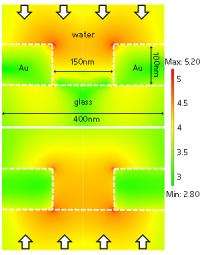Molecular sensors based on nanoholes in metallic films shown to be ideal for medical diagnosis

The detection of small quantities of molecules is important for a myriad of applications, ranging from gas sensing to biomedical diagnostics. The majority of these applications require the sensors to be cheap and disposable, yet sensitive enough to detect molecules down to the single-molecule level. Ping Bai and co-workers at the A*STAR Institute of High Performance Computing and the Institute of Materials Research and Engineering have now studied the properties of thin metallic films with holes in them that are particularly promising for molecular sensing.
Metallic thin films with nanometer-sized holes in them are known to transmit light of particular wavelengths very efficiently. The efficiency arises from surface plasmon polaritons (SPPs) — the collective movements of electrons on the metal surface — which are able to focus light into tiny spots much smaller than the wavelength of light used (see image).
These SPPs can be used to detect the molecules through the fluorescence of tracer molecules attached to them. This fluorescence is also strongly enhanced by the SPP and can easily be detected by a microscope even for small quantities of molecules. “The whole setup is ultra-compact to support a point-of-care sensing system,” explains Bai.
Bai and his colleagues studied two sensing arrangements. In the first arrangement, light is directed at a film with nanoholes at an oblique angle from the same side as the sample. In the second arrangement, the film is illuminated from the back so that light is travelling through the holes first. The researchers found that each scheme has its own advantages.
In the ‘reflection’ scheme, the SPP effect is stronger as the light is directly aimed at the sample and does not have to cross the metal film. However, a thicker film is needed so that the light does not pass through. In the ‘transmission’ scheme, the intensity of the light emitted by the molecules is weaker, but the advantage there is that filters and other sensors can possibly be included with the metal film, and the film thickness can be much thinner.
“There is therefore no clear advantage for either sensing modes of such films,” says Bai. “One thing that is clear from the study, however, is the clear benefits of using metal films with nanoholes as a molecular sensing platform,” says Bai.
“This is merely a snapshot of our whole project. Ultimately, our sensing technology will be utilized in hospitals and test centers, for example, in prostate cancer screening, or even used at home just like glucose test kits,” adds Bai.
More information: Wu, L., Bai, P., Zhou, X. & Li, E. P. Reflection and transmission modes in nanohole-array-based plasmonic sensors. IEEE Photonics Journal 4, 26–33 (2012).




















